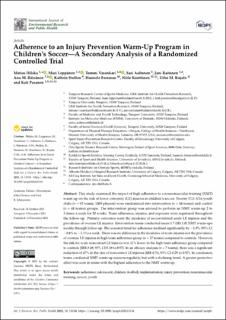Adherence to an injury prevention warm-up program in children’s soccer: A secondary analysis of a randomized controlled trial
Hilska, Matias; Leppänen, Mari; Vasankari, Tommi; Aaltonen, Sari; Raitanen, Jani; Räisänen, Anu M.; Steffen, Kathrin; Forsman, Hannele; Konttinen, Niilo; Kujala, Urho M.; Pasanen, Kati
Peer reviewed, Journal article
Published version

Permanent lenke
https://hdl.handle.net/11250/2986911Utgivelsesdato
2021Metadata
Vis full innførselSamlinger
- Artikler / Articles [2119]
- Publikasjoner fra Cristin [1107]
Originalversjon
International Journal of Environmental Research and Public Health. 2021, 18(24), Artikkel 13134. 10.3390/ijerph182413134Sammendrag
This study examined the impact of high adherence to a neuromuscular training (NMT) warm-up on the risk of lower extremity (LE) injuries in children’s soccer. Twenty U11–U14 youth clubs (n = 92 teams, 1409 players) were randomized into intervention (n = 44 teams) and control (n = 48 teams) groups. The intervention group was advised to perform an NMT warm-up 2 to 3 times a week for 20 weeks. Team adherence, injuries, and exposure were registered throughout the follow-up. Primary outcomes were the incidence of soccer-related acute LE injuries and the prevalence of overuse LE injuries. Intervention teams conducted mean 1.7 (SD 1.0) NMT warm-ups weekly through follow-up. The seasonal trend for adherence declined significantly by −1.9% (95% CI −0.8% to −3.1%) a week. There was no difference in the incidence of acute injuries nor the prevalence of overuse LE injuries in high team adherence group (n = 17 teams) compared to controls. However, the risk for acute noncontact LE injuries was 31% lower in the high team adherence group compared to controls (IRR 0.69, 95% CI 0.49 to 0.97). In an efficacy analysis (n = 7 teams), there was a significant reduction of 47% in the rate of noncontact LE injuries (IRR 0.53, 95% CI 0.29 to 0.97). In conclusion, teams conducted NMT warm-up sessions regularly, but with a declining trend. A greater protective effect was seen in teams with the highest adherence to the NMT warm-up.
Beskrivelse
This article is an open access article distributed under the terms and conditions of the Creative Commons Attribution (CC BY) license (https://creativecommons.org/licenses/by/4.0/).